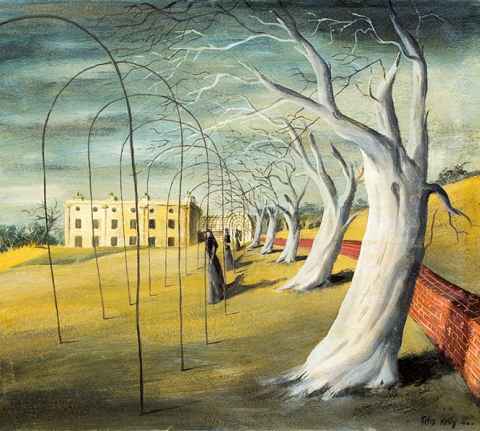Art historian Linda Tyler explains why Three Sisters is her favourite artwork
30 October 2020
The University’s Art Collection has more than 1,700 items spread across five campuses and 90 percent of the collection is on display at all times. Linda Tyler showcases her favourite piece.

Felix Kelly (1915-1994) 'Three Sisters', 1943, oil on paper, 210 x 255mm (see image below)
A wintry, slightly surreal scene, this painting was gifted to the University by the original owner’s daughter-in-law in 2014. How it got to New Zealand is a great story in itself but its intriguing imagery is what draws me to it.
Who are the three sisters, and why are they wandering separately out of a glass house down an arbour of spindly hoops towards the viewer? Are the wintry trees threatening or protecting them? The low red brick wall is an excellent dynamic device to define the rapid recession, and complements the chartreuse grass beautifully. Somehow the glowering sky manages to balance the vertiginous slope of hill on the right too.
So, it is a riddle picture, competently composed but well-removed from New Zealand painting traditions from the middle of last century. Yet the artist was a Kiwi émigré, Felix Kelly, who left Auckland at the height of the Depression in 1935, having won a coveted position as a layout artist at Lintas in London, the advertising wing of Unilever. Highly skilled at networking, and with a fondness for sports cars, he had soon insinuated himself into the English aristocracy, accepting many commissions to depict country houses.

The society magazine 'Tatler' commented on the Felix Kelly works as 'delicious little pictures'. The artist was in Shenley Psychiatric Hospital in Hertfordshire for the duration of the exhibition.
Kelly was an airman in the RAF during wartime but suffered a nervous breakdown and was hospitalised twice in 1943, the year after this painting was completed.
Despite this, he managed to produce six small paintings that were included in the summer exhibition at the prestigious St James gallery, Alex Reid and Lefevre Ltd in August 1943. The society magazine Tatler commented on these as “delicious little pictures”. The artist was in Shenley Psychiatric Hospital in Hertfordshire for the duration of the exhibition.
Perhaps Kelly was inspired by John Gielgud's 1936-37 production of Anton Chekhov’s Three Sisters at the Queen's Theatre in London’s Westend? Or did he admire the grim 1834 portrait of Emily, Charlotte and Anne Brontë by their brother Branwell, which hangs in the National Portrait Gallery in London?
Kelly’s three sisters are Bronte lookalikes, clad in dark Victorian clothing with veiled heads like mourners in a procession. Above, lopsided leafless trees claw the sky, leaning away from the prevailing wind, branches broken on one side by storms.
The effect is to make the three sisters seem like apparitions, or sleepwalkers under a spell. Art historian William Gaunt (1900-1980) has pointed out that Kelly’s figures do not inhabit the scenes in which he places them, so much as haunt them.
To Kelly’s delight, this painting was purchased by the esteemed art critic Herbert Read (1893-1968). Kelly persuaded Read to write the introductory essay for the Falcon Press book Paintings by Felix Kelly (which reproduced 41 of the artists’ works) by agreeing to put this work, which Read owned, on the cover.
Kelly wrote to Read to explain his rather spiritual approach to painting: “Firstly, before commencing a painting I must realise the emotional content of my subject. Secondly, whatever the subject either imaginative or otherwise, I like to compose it not only of the visible but the invisible people or things once there. Thirdly, I suppose it is obvious that the classical symbols of the 18th century have the strongest appeal.”
In Three Sisters, this recipe is evident: the mood is sombre, the figures ghost-like and the architecture Georgian. Perhaps the whole picture is a depiction of the struggle between classical order and romanticism? Or just an imaginative reconfiguring of female figures on the route from the nurse’s home to the hospital during the wartime blackout?
Interpretation remains elusive, which is what makes this tiny work so compelling.
Associate Professor Linda Tyler
This article first appeared in the Spring 2020 edition of Ingenio magazine.
Like to see it in real life? It's now outside Linda's office, Room 206-741.